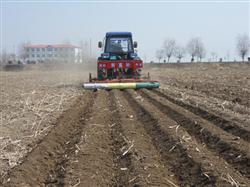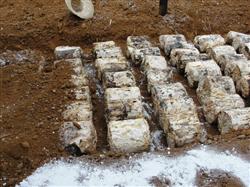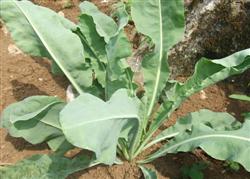Planting of Radix Isatidis: how to grow Radix Isatidis with high yield?

How can Radix Isatidis be planted with high yield? Please give detailed instructions for planting Radix Isatidis if you want to obtain high yield, you can refer to the following methods: first, because Radix Isatidis is a deep-rooted plant, it is appropriate to choose a flat, well-drained, fertile and loose sandy loam. Combined with soil preparation, 2000 kilograms of mature compost or barnyard manure, 100 kilograms of plant ash and 20 kilograms of superphosphate were applied per mu, turning more than 40 centimeters deep, then shallow ploughing once, raking fine and leveling, making a flat bed 1-1.5 meters wide, and watering to make moisture before sowing. Second, the sowing of Radix Isatidis is divided into spring sowing and summer sowing. Spring sowing is in the first and middle of April and summer sowing is in late May. Spring sowing should not be premature, because the seeds will go through the vernalization stage, bolting and flowering ahead of time due to the influence of early spring cold after emergence, and it is invalid to complete the growth period in the same year. Soak the seeds in 30 ℃ ~ 40 ℃ warm water for 4 hours before sowing. Fish it out to dry. Strip sowing and hole sowing can be done. Strip sowing method is often used to trench the border according to the row spacing of 20 cm, and the ditch depth is 1.5 cm. The seeds mixed with fine sand are evenly scattered into the ditch, and the soil is suppressed after covering 0.5 cm, so as to keep the border soil moist. When the temperature is 18 ℃ ~ 20 ℃, seedlings can emerge in 10 days; the row spacing of hole sowing is 25 cm; the germination rate of Radix Isatidis seeds is 70%, and the seeds are 1.5 kg per mu. Third, Banlangen daily management 1. Miao. Seedling height 5 cm 7 cm time seedling, seedling height 10 cm 15 cm fixed seedling, inter-seedling and fixed seedling should be weak and strong, replenish seedlings in time, and keep the soil moist at this stage. two。 Ploughing and weeding. After finishing the seedlings, one time should be ploughed and weeded in time, and then once every half a month or so. After the plants are closed, the weeding should not be carried out. 3. Top dressing. From May to July, 500 kilograms of human feces and urine or 10 kilograms of urea were applied per mu, and 10 kilograms of superphosphate was added and watered after application. Apply 5kg of ammonium sulfate per mu after each leaf harvest (do not use ammonium bicarbonate). 4. Water and drain. It should be watered in time when the summer weather is dry, and pay attention to ditch drainage in the rainy season to prevent rotting roots. 5. The method of reproduction. When propagated with seeds, Radix Isatidis harvested but did not bear seeds in that year. When planing and harvesting Radix Isatidis in late October, select the root strips that are disease-free, sturdy and non-branching of the main root, transplant to the fertile seed field according to the row spacing of 50 cm × 30 cm, water in time after planting, and strengthen field management; the seeds are harvested, dried and threshed in stages from May to June in the second year, and stored in a ventilated and dry place, the roots of Radix Isatidis that have been harvested can no longer be used as medicinal materials. 4. Control methods of diseases and insect pests of Radix Isatidis 1. Disease. There are mainly downy mildew and root rot. Downy mildew leaves showed light green disease spots, white or gray mildew was produced on the back of the leaves, and died in severe cases; root rot mostly occurred in the rainy season, resulting in root rot, resulting in the death of the whole plant. Prevention and control methods: give priority to agricultural control, reasonable rotation and close planting with Gramineae and leguminous plants, improve ventilation and light transmission conditions, and find diseased leaf disease plants removed out of the field in time, concentrated and buried deeply; 65% zinc or 77% can also be sprayed or irrigated with wettable powder. two。 Pests. There are mainly cabbage worm and diamondback moth. Plutella xylostella bites leaves, causing holes and holes in the leaves, leaving only veins in serious cases; Plutella xylostella bites leaves, causing "skylight" at the initial stage, and holes and holes in the later stage, leaving only reticular veins. Diflubenzuron 3, BT emulsion and 1000-fold spray were used to control trichlorfon. Fifth, Banlangen harvesting and processing 1. Daqingye. Spring sowing is harvested 2 to 3 times a year, the first in early June and the second in early August, but it is not suitable to harvest in the hot season in summer, so as not to cause the death of plants. The third harvest is from mid-October to before digging roots. When harvesting, you should choose a sunny day, the knife edge is 1cm away from the ground, pick out the withered and yellow leaves and impurities after cutting, dry them immediately, and avoid stacking them in the drying process, so as not to heat, blacken and deteriorate the leaves. About 200 kilograms of dried leaves are produced per mu and placed in a ventilated and dry place after drying to prevent mildew. two。 Radix Isatidis. Digging roots in late October, because the roots are deep in the soil, we should first dig deep ditches at one end of the border and dig along the ditches to avoid breaking the roots, remove the stems, leaves and soil on the ground, dry them into small bundles, and then dry them to the whole dry, and put them in a dry place to prevent mildew, producing 200 kilograms of finished Radix Isatidis per mu. Click to get more planting techniques of Radix Isatidis
- Prev

What should I pay attention to in Ganoderma lucidum planting technology?
What should be paid attention to in Ganoderma lucidum planting technology? Please introduce the key points of Ganoderma lucidum planting technology as follows: 1. Choose the appropriate cultivation period: The most suitable cultivation period of Ganoderma lucidum is from April 10 to May 10, and after May 20, the bags will be opened one after another. June-July is the rainy season every year, so make sure that all bags are opened before June 10.
- Next

Planting of Radix Isatidis: how to manage it?
How to manage planting Radix Isatidis? Please introduce the daily management methods of Radix Isatidis: the daily management of Radix Isatidis mainly includes field management and pest control. Detailed methods can be referred to the following: field management method of Radix Isatidis: interseedling when seedling height 7~10cm, seedling height 12cm, plant spacing 7: 10.
Related
- Fuxing push coffee new agricultural production and marketing class: lack of small-scale processing plants
- Jujube rice field leisure farm deep ploughing Yilan for five years to create a space for organic food and play
- Nongyu Farm-A trial of organic papaya for brave women with advanced technology
- Four points for attention in the prevention and control of diseases and insect pests of edible fungi
- How to add nutrient solution to Edible Fungi
- Is there any good way to control edible fungus mites?
- Open Inoculation Technology of Edible Fungi
- Is there any clever way to use fertilizer for edible fungus in winter?
- What agents are used to kill the pathogens of edible fungi in the mushroom shed?
- Rapid drying of Edible Fungi

